

How to increase mobile app user engagement? Here are 7 ways how!
How to increase mobile app user engagement? Here are 7 ways how!
In 2022, consumer spending on apps fell for the first time ever. However, this news does not spell doom for apps. Instead, it shows how important mobile user engagement is! Research shows a direct link between user engagement and revenue growth. In other words, mobile app user engagement is the key to success! Find out 7 ways how to boost engagement in 2023.
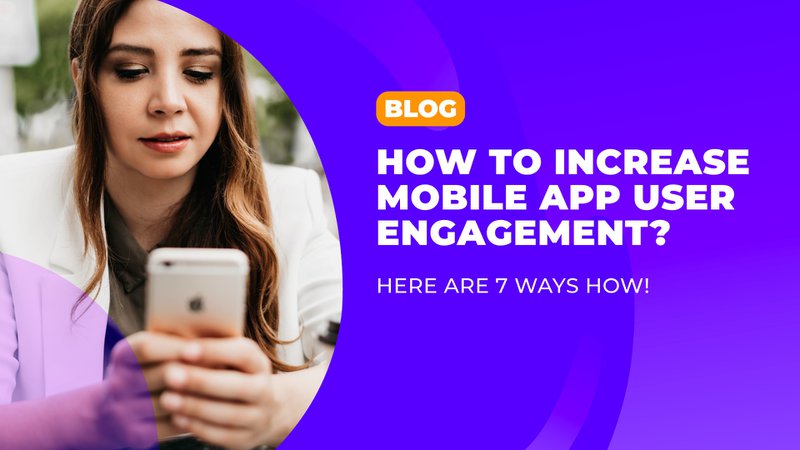
Understanding and improving mobile app user engagement is crucial for growth and profitability, as the following strategies illustrate.
- What exactly is mobile app user engagement?
- What is the role of user engagement in mobile apps?
- 3 mobile app user engagement channels
- How to measure your mobile user engagement
- How do you drive mobile user engagement?
- 7 ways to increase mobile app user engagement
- FAQs
What exactly is mobile app user engagement?
In reality, mobile app user engagement encompasses everything. Every click, view, and download a user performs is user engagement. Essentially, user engagement is a way to track the frequency, duration, and quality of user interactions with your app. The more users engage, the more they get from you, and the more profitable your app will be!
All in all, there are 4 key types of mobile user engagement:
- Contextual. Your app is personalized to the user’s wants and needs.
- Ease-of-use. When engaging is easy! This requires a great UX.
- Emotional. People love to chase the next good feeling.
- Social. The most powerful type of mobile app user engagement!
What is the role of user engagement in mobile apps?
When 1 in 4 mobile app downloaders churn after just one use, increasing your mobile user engagement can result in a serious competitive advantage. That’s because engaged users stick around! In fact, just 10% of new users who engage weekly, churn by Day 30. On the other hand, less engaged users churn at a shocking rate of 77%!
In short, user engagement indicates the health of your business. Apps with a high rate of mobile app user engagement kickstart a positive feedback loop:
- Higher engagement boosts retention.
- Which reduces acquisition costs spending.
- Higher retention increases user lifetime value.
- Retained users are more likely to develop loyalty.
- More loyal users means more advocates for your app.
- And finally, this improves acquisition by creating higher-quality leads!
3 mobile app user engagement channels
While mobile user engagement primarily relies on your app, there are other ways to bring users into the fold. Here are the 3 main channels you can leverage:
1) In-app messaging
With a 40% interaction rate, in-app messages are the most effective channel for mobile user engagement! In brief, in-app messages include things like ‘interstitial’ overlays, headers, footers, and inline notifications that blend in with the user interface. In effect, in-app messages can reach your active users quickly and get them to take target actions.
2) Message centers
Although it is similar to in-app messaging, message centers are unique because they combine all messages into a single space. For one, this avoids intruding on the user experience with potentially unwanted notifications. In addition, unread messages in the center can incentivize users to return to your app.
3) Push notifications
Push notifications are delivered with an onscreen banner alert. Given that, it’s no wonder that the average push notifications opening rate is 50% higher than an email! Ideally, push notifications should be personalized and contain contextual or timely information. Otherwise, you risk being treated like spam!
How to measure your mobile user engagement
Learning how to measure your mobile app user engagement is key to creating growth. But when there are dozens of different metrics, how do you know which to use and when? In effect, each metric shows something different about your app.
Let’s sum up 6 essential metrics and what they reveal:
#1 Daily/Monthly Active Users (DAU/MAU rate)
Daily active users / Monthly active users = DAU/MAU rate
Briefly, the DAU/MAU rate shows how sticky your app is. The more daily users you have, the more engaging your app is!
#2 Stickiness Ratio
DAU/MAU rate * 100 = %
Take the DAU/MAU Ratio one step further! The stickiness ratio reveals how much repeated mobile user engagement you generate. In general, a score of 20% is good. Still, the sky is the limit! The world’s top apps like Instagram have a stickiness ratio of 50%.
#3 Churn Rate
(Users who left in time period / Total users) * 100 = %
A churned user is a user who can no longer engage! In short, high churn could mean that you are acquiring poor-quality leads or even that your app experience is off-putting. Keep track of this metric to ensure that you are heading in the right direction.
#4 Session Duration
Duration of all sessions / Number of sessions = Average session duration
This calculates the time a user spends on your app. But what’s a good result? That depends on what kind of app you operate. For example, functional apps like those in banking report an average session duration of 5.5 minutes, whereas ecommerce apps can hit up to 11 minutes.
#5 Session Intervals
This one is easy - it’s simply the amount of time between consecutive app sessions. The shorter the interval, the more hooked your user is!
#6 Feature Usage
(Feature users / Total users) * 100 = %
You might want to increase mobile app user engagement on certain features. For this, you can also work out the DAU/MAU rate of a feature, and the time intervals between feature usage. To be sure, these metrics will produce actionable data for you to optimize!
How do you drive mobile user engagement?
Since user engagement encompasses everything, it can be challenging to narrow down what affects it. However, there’s one thing that always creates engaged users. And that’s a great user experience! In practice, you can facilitate user engagement with an intuitive user interface, a user journey that flows well, and simply by providing value.
But more than that, you can drive mobile app user engagement with these 7 strategies:
7 ways to increase mobile app user engagement
#1 App Gamification
People engage for longer with games than any other app vertical. Simply put, that’s because games are fun! Of course, that doesn’t mean you should make your app a game. Instead, app gamification is a way to borrow the exciting features of a game and make it apply to your audience and goals. In essence, gamification relies on 4 simple mechanics:
- Achievement. Badges and levels celebrate user engagement!
- Competition. People are naturally social and competitive.
- Feedback. Instant feedback positively reinforces the user.
- Reward. Points, perks, and bonuses! Whatever you want to call it, rewards are extremely motivating and help give tasks purpose.
Perhaps the most famous instance of app gamification is Duolingo. By using game-like features, the language learning app engages 42 million monthly active users! To provide an example, take the badge reward system. For users, badges are a visual way to review progress and validate their skills. Not to mention, they can be used to brag to friends. Maybe that’s why, after Duolingo implemented badges, user referrals jumped by 116%!
Sounds great, right? But to be effective, you can’t simply tack on a badge reward system. Rather, you need a gamification strategy built from the ground up for your app.
Gamify your app! Our App Gamification Software can kickstart your user experience today. Discover how!
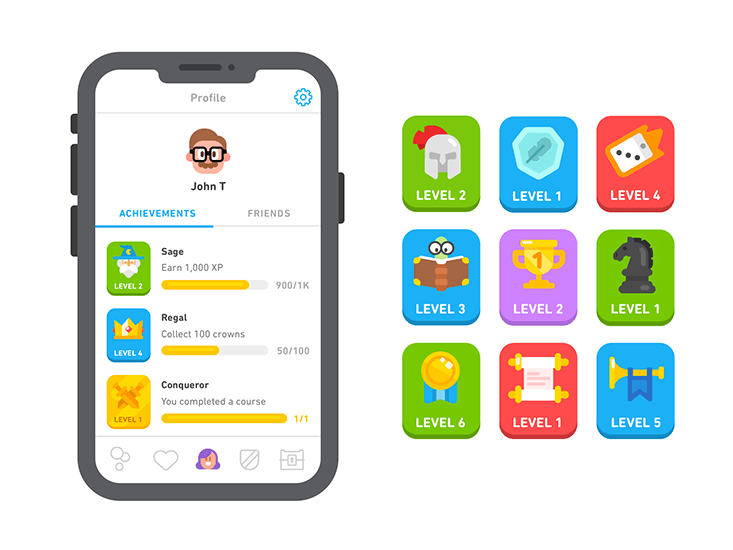
Duolingo's badge system is a prime example of how gamification celebrates user achievement and drives engagement.
#2 Build a community with social features
Social relatedness is arguably the most powerful motivation there is. Basically, when you satisfy what psychologists call ‘the need to belong’, you foster intrinsic motivation. In other words, users enjoy the experience! That’s because forming social attachments “produces positive emotions”. And you can harness this power with an app community! In fact, the results of in-app communities are amazing:
- 500% return on investment for apps that build an in-app community
- Users who join in-app communities spend 19% more
- B2B companies see a 54% uplift in user retention
For a great example, take SWEAT. In 2 short years, SWEAT became the world’s most profitable fitness app! So what did they do right? After a workout, SWEAT users are encouraged to share a selfie with their friends. What’s more, the app has forums where users can discuss recipes, and exercises, and even find a workout buddy!
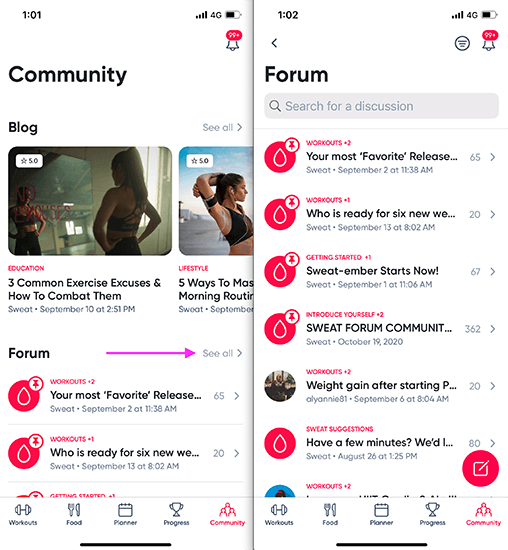
The SWEAT app leverages community features, like sharing post-workout selfies, to foster a sense of belonging and motivate users.
#3 Make the most of push notifications
Push notifications are powerful, but they can backfire. If your copy is boring or simply not valuable to the user, you can drive them away. So what’s the right way to use a push notification? Look at the example of Songkick.
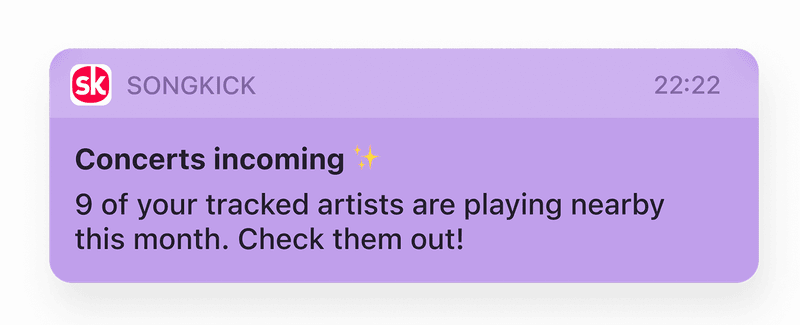
This Songkick push notification effectively combines personalization, urgency, and a clear call-to-action, which are key elements for success.
- Clear CTA to return to the app
- Contextual info, such as user location
- Emoji makes the message fun and visual
- Personalized offer with the user’s favorite artists
- Time-limited pressure of “this month” incentivizes action
With this, Songkick ensures that its message delivers value and justifies its use as an intrusive push notification. All that in just two short sentences!
#4 A loyalty system incentivizes continued engagement
Loyalty is the ultimate goal! Indeed, loyal users spend more and are more likely to refer others to your app. But to create loyalty, you first need your users to engage. That’s why events app Fever makes mobile user engagement the bedrock of their loyalty system. Essentially, the more often a user engages, the bigger the discount that Fever users get!
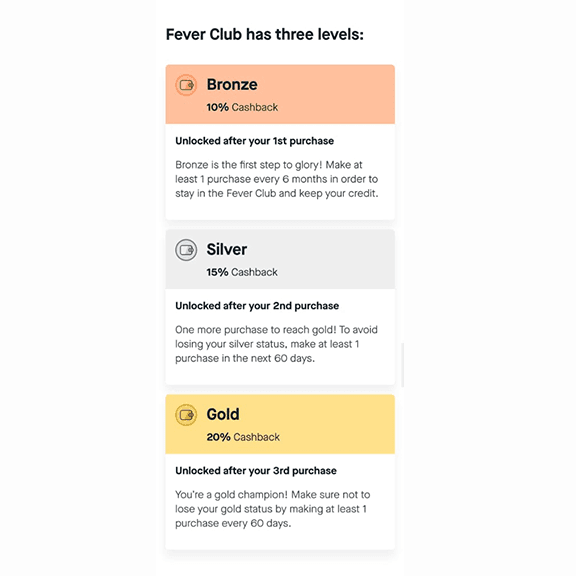
The Fever app's loyalty system directly ties user engagement to tangible rewards, encouraging repeat use and deeper interaction.
#5 Boost user referrals to create the “Network Effect”
Maximizing engagement requires more than engaging just your existing users. Indeed, you also need to acquire better quality leads - and referred users are 5 times more likely to engage! What’s more, users that refer others are also more likely to engage. That’s due to the ‘Network Effect’. In other words, an app is more useful with more users on it!
For instance, take neobank app Revolut. Of course, features like bill splitting or shared saving vaults are more useful if you have friends that also use the app. So, to incentivize referrals, Revolut rewards each user with €10! In fact, the science endorses this method:
Impact of Incentive Mechanism in Online Referral Programs - "Equal-split rewards result in more conversions. It increases the invitee’s likelihood to accept a referral, due to selective and better targeted referrals."
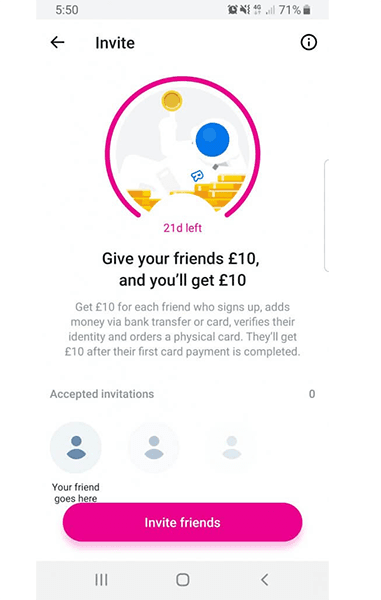
Revolut's referral program uses a mutual reward system to great effect, leveraging the Network Effect to grow its user base.
#6 Make your onboarding interactive
When it comes to establishing mobile user engagement and retention, no stage is more important than onboarding! Indeed, reports show that just 17% of people engage with an app 24 hours after installation. That could be because the process fails to set up the app’s value - or it’s simply long and boring. In fact, each onboarding step churns 20% of users.
To reduce onboarding churn, make the experience interactive! Interactive onboarding compels users to engage, rather than to passively skip through screens. In short, it gives each step meaning! For example, wellness app Calm asks users to pick their personal goals. As well, this sets up the promise of “personalized recommendations” which entices users to continue engaging!
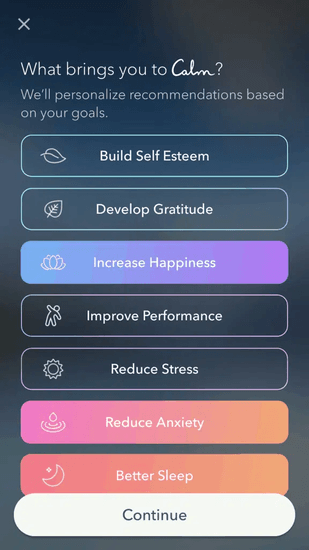
The Calm app makes its onboarding process interactive by asking users about their goals, which immediately personalizes the experience and increases buy-in.
#7 Use progressive profiling to know your users better
The more you know about your user, the more you can personalize their experience. In turn, this boosts their mobile app user engagement! But you can’t ask new users for their information all at once. Indeed, research shows how this creates harmful friction:
Okta - "86% of users say overly long forms make them quit on registrations."
To effectively build a user profile, you need to use progressive profiling. Essentially, this means learning the user’s details over time. This can improve conversion rates by 20%! For instance, the H&M app does not require tons of information to sign up. Instead, H&M gives new users a checklist of tasks. One of these tasks is to complete the profile set-up, where users share details like their gender, location, and birthday. In the end, users who complete this task earn points which can be used to spend in the store!
As a result, users are more likely to give away their details. In turn, this lets H&M better personalize its offers and incentivize further mobile user engagement. For example, they give users an exclusive 25% discount on their birthday! Now that’s a win-win!
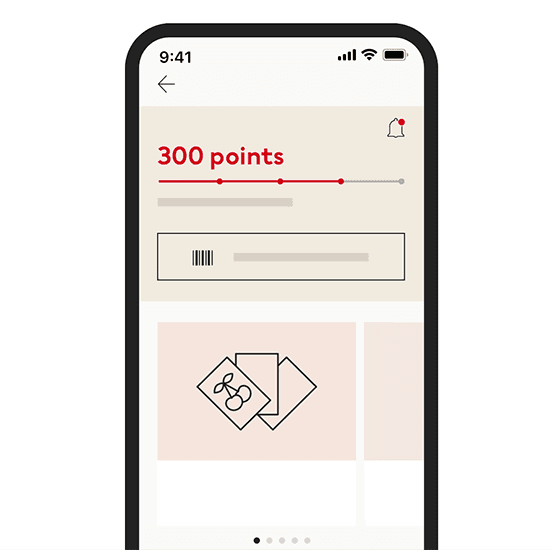
H&M's app uses progressive profiling, rewarding users with points for completing their profile, which in turn allows for better personalization and engagement.
FAQs
How do you define mobile user engagement?
Essentially, user engagement tracks the frequency, duration, and quality of your app’s user interactions. In fact, every click, view, and download counts as user engagement! And the more users that engage, the more profitable your app will be!
What is the role of user engagement in mobile apps?
In short, mobile user engagement indicates the health of your business. It shows that you can create profitable, loyal users. That’s because engaged users have a higher rate of retention, generate more data you can leverage, and spend up to 3x more!
How do you increase mobile app user engagement?
Games garner more engagement than any other app vertical — and that’s something all apps can learn from. To boost engagement and improve the user experience, you can use gamification. For example, after Duolingo implemented badges their user referrals jumped by 116%!
Related Posts

Interview: Here’s why AB InBev is focusing on digital engagement (and why you should too)
AB InBev, the biggest brewery in the world and also an avid sponsor of live sports events, is shifting focus to better serve its customers during the Corona outbreak. We had the opportunity to interview the AB InBev Europe innovation lead Michael Codd about handling communication, digital brand activation and esports.

How to hack growth like Revolut (the secret is mobile app engagement!)
Today, almost 50% of people exclusively do digital banking! That number is only set to grow even further! The fastest-growing digital bank in Europe is Revolut, which boasts 15 million+ customers. The app exploded in just 6 short years through the clever use of gamification. Want to find out how they succeeded while others didn't? Check out the full article!

